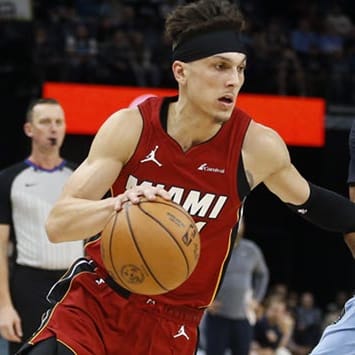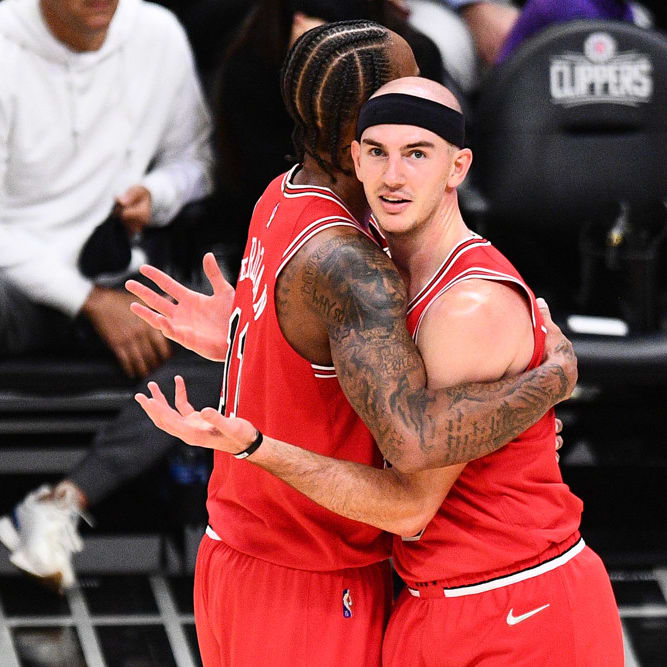This article is part of our NBA Injury Analysis series.
RotoWire's Jeff Stotts breaks down what you need to know about the injuries most affecting fantasy basketball in Week 16
Clint Capela, Wendell Carter, Jr., and Spencer Dinwiddie
Thumb sprains have suddenly become the in-vogue injury of the NBA season. Multiple players, headlined by Capela, Carter, and Dinwiddie, have sustained the injury in recent weeks, sending them to the sidelines.The thumb is made of three bones, the proximal and distal phalanges and the first metacarpal of the hand. The proximal phalanx and first metacarpal form the metacarpophalangeal (MCP) joint near the base of the thumb. Two ligaments, the ulnar collateral ligament (UCL) and the radial collateral ligament (RCL), fortify the MCP joint and prevent excessive motion. The UCL is the primary stabilizer and sits on the inside of the thumb.
UCL thumb sprains occur more frequently than RCL sprains, most often after a player gets hung up on something like a base in baseball or in an opponent's jersey. Surgery is often the best course of treatment to repair the sustained damage. Multiple NBA players have suffered the injury, including Larry Sanders, Shaquille O'Neal, and Chris Paul. Since the 2005-06 NBA season, the average number of missed games for in-season UCL repairs is 26.2 games or roughly seven weeks.
Fortunately a new technique in surgery has recently emerged and the return to play is improving. For example, Chris Paul was back in action after missing 14 games. The technique includes an internal brace that allows
RotoWire's Jeff Stotts breaks down what you need to know about the injuries most affecting fantasy basketball in Week 16
Clint Capela, Wendell Carter, Jr., and Spencer Dinwiddie
Thumb sprains have suddenly become the in-vogue injury of the NBA season. Multiple players, headlined by Capela, Carter, and Dinwiddie, have sustained the injury in recent weeks, sending them to the sidelines.The thumb is made of three bones, the proximal and distal phalanges and the first metacarpal of the hand. The proximal phalanx and first metacarpal form the metacarpophalangeal (MCP) joint near the base of the thumb. Two ligaments, the ulnar collateral ligament (UCL) and the radial collateral ligament (RCL), fortify the MCP joint and prevent excessive motion. The UCL is the primary stabilizer and sits on the inside of the thumb.
UCL thumb sprains occur more frequently than RCL sprains, most often after a player gets hung up on something like a base in baseball or in an opponent's jersey. Surgery is often the best course of treatment to repair the sustained damage. Multiple NBA players have suffered the injury, including Larry Sanders, Shaquille O'Neal, and Chris Paul. Since the 2005-06 NBA season, the average number of missed games for in-season UCL repairs is 26.2 games or roughly seven weeks.
Fortunately a new technique in surgery has recently emerged and the return to play is improving. For example, Chris Paul was back in action after missing 14 games. The technique includes an internal brace that allows the injured individual to begin movement earlier in the recovery process.
In Houston, Capela is expected back at the All-Star break. In the meantime, the recently signed Kenneth Faried has emerged as a viable fantasy option. The Manimal is averaging 14.3 points, 9.5 rebounds, 1.3 steals, and 1.3 blocks while shooting 61 percent from the field since donning a Rockets jersey.
Carter is expected to miss a considerable amount of time as the Bulls have placed his recovery window at 8-to-12 weeks. The prolonged timeline is likely linked to Chicago's current place in the standing with the team opting to focus on the future of the franchise.
Dinwiddie remains without a timeline following his surgery earlier in the week. A return this season could be complicated as it appears Dinwiddie sustained damage to multiple ligaments. His recovery will be fluid though fantasy owners should consider other alternatives for the remainder of the season. D'Angelo Russell will continue to see an increase in responsibilities with Dinwiddie out with Shabazz Napier also in line for extra minutes.
Anthony Davis
Amid the swirling trade rumors, Davis is currently sidelined with an index finger injury. Davis suffered an avulsion fracture of the volar plate, a fibrocartilage structure that increases the articulating surface of the finger joints while providing protection and additional stability. The volar plate sits on the palm side of the hand between the proximal and middle bones of each finger at a joint known as the proximal interphalangeal (PIP) joint. While it is designed to limit excessive extension of the PIP, the volar plate can be injured if the joint is forced into hyperextension. This mechanism of injury often causes the volar plate to pull away a small piece of bone.Fortunately for the Pelicans, or perhaps for another team that could acquire him before Feb. 7, Davis will not require surgery. He's instead opted for conservative treatment that includes managing the symptoms and bracing the area. The nonoperative approach has a high success rate and good prolonged outcomes. Davis should be healthy enough to play within the next week, though his current status remains in limbo thanks to his trade request.
A slimmed-down Jahlil Okafor has played surprisingly well in Davis' absence, averaging 19.9 points, 10.8 rebounds, and 2.8 blocks per game over New Orleans' last four outings.
Victor Oladipo
The Pacers guard will miss the remainder of the season after tearing his quadriceps tendon last week.The quadriceps is a dynamic muscle group that plays a role in both hip and knee movement. The four muscles of the quad are connected to the lower leg by a conjoined tendon. The patella (kneecap) sits within this tendon. The portion of the tendon above the kneecap is referred to as the quadriceps tendon while the inferior portion that connects the muscle to the tibia is known as the patellar tendon.
The tendon can rupture or tear at both locations, disrupting motion at the knee. Tendon tears at the knee are relatively uncommon in the NBA with most tears occurring at the patellar tendon. Players including Caron Butler, Jeremy Lin, and Hassan Whiteside have all missed time after tearing their patellar tendons. Thunder guard Andre Roberson is still recovering from a patellar tendon tear suffered last January, though multiple setbacks have delayed his return.
The best NBA comparison for Oladipo is probably veteran Tony Parker. The former Spurs and current Hornets point guard suffered a torn quadriceps tendon during the 2017 playoffs. He underwent surgery to repair the damage and returned to action after 208 days (nearly seven months). If the considerably younger Oladipo can follow a similar timeline, he has a realistic shot at being back in time for the start of training camp in the fall. The road to recovery will be a difficult one, but Oladipo should be positioned for a return next season.
Lonzo Ball
The Lakers are dealing with an assortment of injuries. Both LeBron James and Kyle Kuzma will sit out Tuesday's game against Philadelphia, though neither player is expected to miss much more time. With Rajon Rondo back following a lengthy injury layoff of his own, Ball's ankle injury becomes the primary focus for the Lakers medical staff.Ball has not played since spraining his ankle in a Jan. 10 loss to the Rockets. Testing on the injury revealed a Grade 3 sprain, meaning the structural integrity of the involved ligament or ligaments has been compromised. Individuals suffering Grade 3 sprains often report significant pain and a loss of function and stability. Injuries of this severity often require a considerable recovery time and, in some cases, surgery. Last season, Pistons guard Reggie Jackson missed 37 games with a Grade 3 sprain. As a result, it wouldn't be surprising to see Ball remain out until early March.
Rondo is certainly a capable fill-in for the Lakers at point guard, but he has his limitations as a scorer and doesn't always bring the same intensity as Ball on the defensive end. Regardless, barring a trade, all signs point to the Lakers going forth with Rondo as the starter until Ball is back to full strength. In his first two games back, Rondo is averaging 11.5 points, 12.0 assists and 5.0 rebounds in 39.5 minutes, but those numbers figure to regress to at least some degree once James returns to the lineup.










